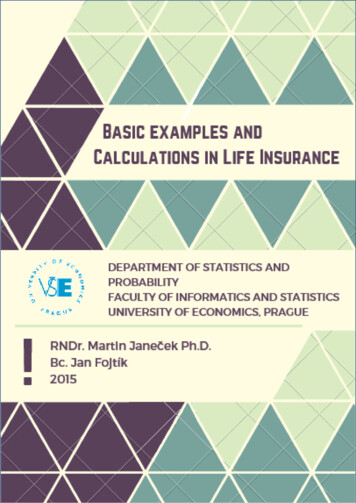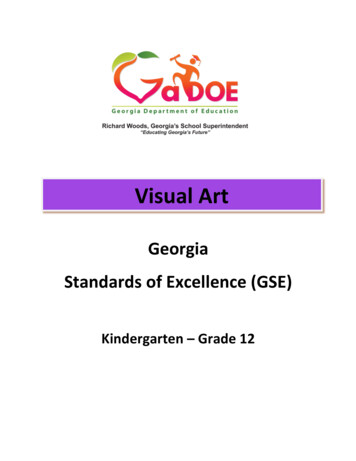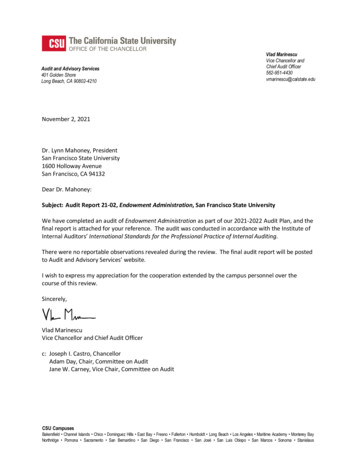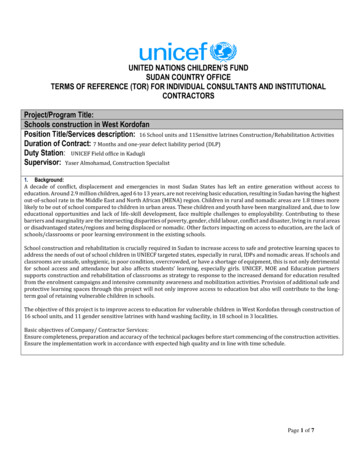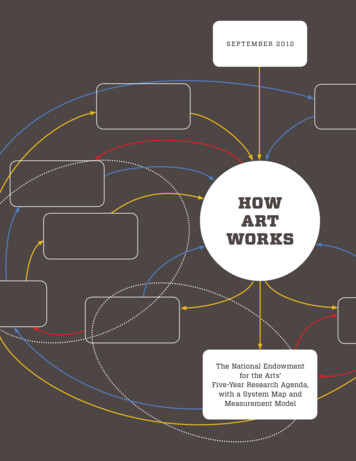
Transcription
SEPTEMBER 2012HOWARTWORKSThe National Endowmentfor the Arts’Five-Year Research Agenda,with a System Map andMeasurement Model
HowArtWorksThe National Endowmentfor the Arts’Five-Year Research Agenda,with a System Map andMeasurement ModelS e p tem b er 2 0 1 2
September 2012National Endowment for the Arts1100 Pennsylvania Avenue, NWWashington, DC 20506-0001Telephone: 202-682-5400arts.govBased on a manuscript prepared by Monitor InstituteProduced by the NEA’s Office of Research & AnalysisSunil Iyengar, DirectorEllen Grantham, Program AnalystRichard Heeman, Program AnalystRoman Ivanchenko, Program AnalystBonnie Nichols, Research AnalystTamika Shingler, Research & Administrative SpecialistSteven Shewfelt, Deputy DirectorJoanna Woronkowicz, Senior Research OfficerDesigned by Beth Schlenoff DesignPrinted in the United States of AmericaLibrary of Congress Cataloging-in-Publication DataNational Endowment for the Arts.How art works : the National Endowment for the Arts’ five-yearresearch agenda, with a system map and measurement model.pages cm“Based on a manuscript prepared by Monitor Institute.”“September 2012.”1. Arts and society—United States—History—21st century.2. National Endowment for the Arts. I. Title.NX180.S6N38 6 Voice/TTY(a device for individuals who are deaf or hearing-impaired)Individuals who do not use conventional print materials may contact the Arts Endowment’sOffice for Accessibility at 202-682-5532 to obtain this publication in an alternate format.This publication is available free of charge in print or PDF format at arts.gov, the websiteof the National Endowment for the Arts.
CONTENTSP re fac e. . . . . . . . . . . . . . . . . . . . . . . . . . . . . . . . . . . . . . . . . . . . . . . . . . . . . . . . . . . . . . . . . . . . . . . . . . . . . . . . . . . . . . . . . . . . . . . 5. . . . . . . . . . . . . . . . . . . . . . . . . . . . . . . . . . . . . . . . . . . . . . . . . . . . . . . . .6. . . . . . . . . . . . . . . . . . . . . . . . . . . . . . . . . . . . . . . . . . . . . . . . . . . . . . . . . . . . . . . . . . . . . . . . . . . . . . . . . . . . . . . . . .8b ac k g r ou n d N o t e O n G oa l s A n d M e t h o d sW h y A S ystem M a p ?Section OneE sta b l i s h i n g A T h e o ry Of H o w A rt W o r k s A s A S ystemS e c t i o n T wo . . . . . . . . . . . . . . . . . . . . . . . . . . . . . . . . . . . . . . . . . . . . . . . . . . . . . . . . . . . . . . . . . . . . . . . . . . . . . . . . . . . . . . . . . 1 1M a p p i n g T h e S ystem Of H o w A rt W o r k sOverview . . . . . . . . . . . . . . . . . . . . . . . . . . . . . . . . . . . . . . . . . . . . . . . . . . . . . . . . . . . . . . . . . . . . . . . . . . . . . . . . . . . . . . . . . . . . 1 1System Components . . . . . . . . . . . . . . . . . . . . . . . . . . . . . . . . . . . . . . . . . . . . . . . . . . . . . . . . . . . . . . . . . . . . . . . . . . . . . . . . . . 1 2Human Impulse to Create and Express . . . . . . . . . . . . . . . . . . . . . . . . . . . . . . . . . . . . . . . . . . . . . . . . . . . . . . . . . . . . . . . 1 2Inputs . . . . . . . . . . . . . . . . . . . . . . . . . . . . . . . . . . . . . . . . . . . . . . . . . . . . . . . . . . . . . . . . . . . . . . . . . . . . . . . . . . . . . . . . . . . 1 2Art . . . . . . . . . . . . . . . . . . . . . . . . . . . . . . . . . . . . . . . . . . . . . . . . . . . . . . . . . . . . . . . . . . . . . . . . . . . . . . . . . . . . . . . . . . . . . . 1 3Quality-of-Life Outcomes (First-Order Outcomes) . . . . . . . . . . . . . . . . . . . . . . . . . . . . . . . . . . . . . . . . . . . . . . . . . . . . 1 3Broader Societal Impacts (Second-Order Outcomes) . . . . . . . . . . . . . . . . . . . . . . . . . . . . . . . . . . . . . . . . . . . . . . . . . . . 1 3System Multipliers . . . . . . . . . . . . . . . . . . . . . . . . . . . . . . . . . . . . . . . . . . . . . . . . . . . . . . . . . . . . . . . . . . . . . . . . . . . . . . . . . . . 14S e c t i o n Th r e e. . . . . . . . . . . . . . . . . . . . . . . . . . . . . . . . . . . . . . . . . . . . . . . . . . . . . . . . . . . . . . . . . . . . . . . . . . . . . . . . . . . . . . . 17D i sse c t i n g T h e M a p F o r T h e P u r p o se Of M eas u rementOverview . . . . . . . . . . . . . . . . . . . . . . . . . . . . . . . . . . . . . . . . . . . . . . . . . . . . . . . . . . . . . . . . . . . . . . . . . . . . . . . . . . . . . . . . . . . . 17Initial Construct of Input Variables . . . . . . . . . . . . . . . . . . . . . . . . . . . . . . . . . . . . . . . . . . . . . . . . . . . . . . . . . . . . . . . . . . . . 1 8Arts Infrastructure . . . . . . . . . . . . . . . . . . . . . . . . . . . . . . . . . . . . . . . . . . . . . . . . . . . . . . . . . . . . . . . . . . . . . . . . . . . . . . . . 1 8Education and Training . . . . . . . . . . . . . . . . . . . . . . . . . . . . . . . . . . . . . . . . . . . . . . . . . . . . . . . . . . . . . . . . . . . . . . . . . . . . 2 1Initial Construct of Intervening Variables . . . . . . . . . . . . . . . . . . . . . . . . . . . . . . . . . . . . . . . . . . . . . . . . . . . . . . . . . . . . . . . 2 1Arts Creation . . . . . . . . . . . . . . . . . . . . . . . . . . . . . . . . . . . . . . . . . . . . . . . . . . . . . . . . . . . . . . . . . . . . . . . . . . . . . . . . . . . . . 21Arts Participation . . . . . . . . . . . . . . . . . . . . . . . . . . . . . . . . . . . . . . . . . . . . . . . . . . . . . . . . . . . . . . . . . . . . . . . . . . . . . . . . . 2 1Initial Construct of First-Order Outcome Variables . . . . . . . . . . . . . . . . . . . . . . . . . . . . . . . . . . . . . . . . . . . . . . . . . . . . . . 27Direct and Indirect Economic Benefits of Art . . . . . . . . . . . . . . . . . . . . . . . . . . . . . . . . . . . . . . . . . . . . . . . . . . . . . . . . . 27Benefit of Art to Individuals . . . . . . . . . . . . . . . . . . . . . . . . . . . . . . . . . . . . . . . . . . . . . . . . . . . . . . . . . . . . . . . . . . . . . . . . 27Benefit of Art to Society and Communities . . . . . . . . . . . . . . . . . . . . . . . . . . . . . . . . . . . . . . . . . . . . . . . . . . . . . . . . . . . . 2 9Initial Construct of Second-Order Outcome Variable: A Work in Progress . . . . . . . . . . . . . . . . . . . . . . . . . . . . . . . . . . 2 9Societal Capacities to Innovate and to Express Ideas . . . . . . . . . . . . . . . . . . . . . . . . . . . . . . . . . . . . . . . . . . . . . . . . . . 2 9S e c t i o n F ou r. . . . . . . . . . . . . . . . . . . . . . . . . . . . . . . . . . . . . . . . . . . . . . . . . . . . . . . . . . . . . . . . . . . . . . . . . . . . . . . . . . . . . . . . 3 2P l o tt i n g A R esear c h A g enda On T h e M a pOverview and Key Assumptions . . . . . . . . . . . . . . . . . . . . . . . . . . . . . . . . . . . . . . . . . . . . . . . . . . . . . . . . . . . . . . . . . . . . . . . 3 2Finding Previous NEA Research on the Map . . . . . . . . . . . . . . . . . . . . . . . . . . . . . . . . . . . . . . . . . . . . . . . . . . . . . . . . . . 3 3From System Map to Road Map . . . . . . . . . . . . . . . . . . . . . . . . . . . . . . . . . . . . . . . . . . . . . . . . . . . . . . . . . . . . . . . . . . . . . 3 3NEA Research Agenda by Project Title, Summary, and Placement on the System Map . . . . . . . . . . . . . . . . . . . . . 3 4Analysis . . . . . . . . . . . . . . . . . . . . . . . . . . . . . . . . . . . . . . . . . . . . . . . . . . . . . . . . . . . . . . . . . . . . . . . . . . . . . . . . . . . . . . . . . . . . 3 8Conclusions . . . . . . . . . . . . . . . . . . . . . . . . . . . . . . . . . . . . . . . . . . . . . . . . . . . . . . . . . . . . . . . . . . . . . . . . . . . . . . . . . . . . . . . . . 3 9The NEA’s Inaugural Research Grants Portfolio . . . . . . . . . . . . . . . . . . . . . . . . . . . . . . . . . . . . . . . . . . . . . . . . . . . . . . 41how art wo rks 3
i l l u s t r at i o n s11ILLUSTR ATION 1. . . . . . . . . . . . . . . . . . . . . . . . . . . . . . . . . . . . . . . . . . . . . . . . . . . . . . . . . . . . . . . . . . . . . . . . . . . . . . . . . . . . . .ILLUSTR ATION 2. . . . . . . . . . . . . . . . . . . . . . . . . . . . . . . . . . . . . . . . . . . . . . . . . . . . . . . . . . . . . . . . . . . . . . . . . . . . . . . . . . . . . . 1 5ILLUSTR ATION 3. . . . . . . . . . . . . . . . . . . . . . . . . . . . . . . . . . . . . . . . . . . . . . . . . . . . . . . . . . . . . . . . . . . . . . . . . . . . . . . . . . . . . .ILLUSTR ATION 4. . . . . . . . . . . . . . . . . . . . . . . . . . . . . . . . . . . . . . . . . . . . . . . . . . . . . . . . . . . . . . . . . . . . . . . . . . . . . . . . . . . . . . 1 9ILLUSTR ATION 5. . . . . . . . . . . . . . . . . . . . . . . . . . . . . . . . . . . . . . . . . . . . . . . . . . . . . . . . . . . . . . . . . . . . . . . . . . . . . . . . . . . . .ILLUSTR ATION 6. . . . . . . . . . . . . . . . . . . . . . . . . . . . . . . . . . . . . . . . . . . . . . . . . . . . . . . . . . . . . . . . . . . . . . . . . . . . . . . . . . . . .ILLUSTR ATION 7. . . . . . . . . . . . . . . . . . . . . . . . . . . . . . . . . . . . . . . . . . . . . . . . . . . . . . . . . . . . . . . . . . . . . . . . . . . . . . . . . . . . .ILLUSTR ATION 8. . . . . . . . . . . . . . . . . . . . . . . . . . . . . . . . . . . . . . . . . . . . . . . . . . . . . . . . . . . . . . . . . . . . . . . . . . . . . . . . . . . . .ILLUSTR ATION 9. . . . . . . . . . . . . . . . . . . . . . . . . . . . . . . . . . . . . . . . . . . . . . . . . . . . . . . . . . . . . . . . . . . . . . . . . . . . . . . . . . . . .How Art Works System MapHow Art Works System Map with MultipliersHow Art Works Expanded System Map17Example of Arts Infrastructure as a Multi-Level Measurement StructureExample of Education and Training as a Multi-Level Measurement StructureExample of Arts Creation as a Multi-Level Measurement StructureExample of Arts Participation as a Multi-Level Measurement StructureExample of Direct and Indirect Economic Benefits of Art as a Multi-Level Measurement StructureExample of Benefit of Art to Individuals as a Multi-Level Measurement Structure2022232426ILLUSTR ATION 1 0 . . . . . . . . . . . . . . . . . . . . . . . . . . . . . . . . . . . . . . . . . . . . . . . . . . . . . . . . . . . . . . . . . . . . . . . . . . . . . . . . . . . . 2 8Example of Benefit of Art to Society and Communities as a Multi-Level Measurement StructureILLUSTR ATION 1 1. . . . . . . . . . . . . . . . . . . . . . . . . . . . . . . . . . . . . . . . . . . . . . . . . . . . . . . . . . . . . . . . . . . . . . . . . . . . . . . . . . . . . 37NEA Research Projects for Fiscal Years 2012–2016, Identified by Primary Node on the How Art Works System Map4 nat i o nal e n dowme n t for the art s
P REFA CEThis document sets forth the National Endowmentfor the Arts’ five-year agenda for research, but it doesmore than that. It provides a conceptual frame forplanning and assessing research priorities so thatthe NEA can improve its ability to meet a core goal:To Promote Knowledge and Understanding about theContributions of the Arts.This goal appears in the NEA’s Strategic Plan for FY2012–2016. The plan charges the Arts Endowment’sOffice of Research & Analysis (ORA) with drafting afive-year research agenda with annual milestones forreporting to the White House Office of Management& Budget, Congress, and the American public. Thus,in 2011 ORA developed operating principles for theresearch agenda and presented them for feedback froma variety of stakeholders. (To view the presentation,visit rrent with that process, the agency embarkedon a series of in-depth dialogues —through interviews,webinars, and workshops—with leading thinkers in avariety of fields and sectors not exclusive to the arts.The goal of those consultations was to establish afeasible, testable hypothesis for understanding how artworks in American life.The rationale for this approach was two-fold. First,much of the NEA’s past research on arts and culturehas responded directly to the availability of specificdatasets; to that extent, such research has been largelydescriptive and reactive, rather than theory-drivenand pro-active. The second reason for attempting tooutline “how art works” is that a theory of changewould enable us better to study the arts as a completesystem, and thus allow us more clearly to define thearts’ “value” and “impact.” Understanding those termsis crucial if the NEA is to track progress on achievingits strategic outcome for all research activity: Evidenceof the Value and Impact of the Arts is Expanded andPromoted.The result of the NEA’s deliberations and expertconsultations was a system map and measurement model (shown in Sections Two and Three ofthis report) that can guide ORA’s annual milestonedevelopment process as part of its five-year researchagenda. This report (in Section Four) lists priorityresearch projects that have emerged from ORA’s ownoperating principles, but it also aligns those projectswith key variables identified by the system map. Themap organizes the research in a way that permitsgreater exploration of gaps and opportunities.The NEA’s Office of Research & Analysis is indebtedto a long list of bibliographical resources, interviewsubjects, and workshop and webinar participantsfor assisting its pursuit of a theory-driven map andmeasurement model to guide future work. (Thoseresources and individuals are credited in two onlineappendices, available here: arts.gov/research/HowArt-Works/index.html.) In particular, ORA relied onthe expertise of Tony Siesfeld, Andrew Blau, LancePotter, Don Derosby, Jessica Gheiler, and the MonitorGroup. We now welcome broader public engagementwith scholars, arts practitioners, and policy-makers sothat the report can provoke fresh research and insightsabout the value and impact of the arts in America.Sunil IyengarDirector, Research & AnalysisNational Endowment for the Artshow art wo rks 5
B A CKGROUND NOTE ON GO A LS A ND M ET H ODSWHY A SYSTE M M AP?This report stems from a collaborative researchinquiry into the nature and consequences of art inAmerican life. Although it culminates in a researchagenda for the National Endowment for the Arts, thedocument also proposes a way for the nation’s culturalresearchers, arts practitioners, policy-makers, and thegeneral public to view, analyze, and discuss the arts asa dynamic, complex system.It is characteristic of complex systems that theyafford many points of entry and many different vantages, according to the user. Such systems also have manymoving parts, which often interact in mysterious ways.It is frequently the case that examining one or more ofthese parts in isolation will fail to reveal the cumulative effect of the system or its emergent properties.A well-established technique for managing thiscomplexity, for the purpose of analysis, is to create asystem map. The tool has been used widely in commerce to understand markets, value chains, the birthof new sectors, and how information flows within thewalls of a business. System maps have figured in a variety of fields and sectors, ranging from neuroscienceand public health to the evolution of economies.The arts are a dynamic, complex system. They havea rich intellectual history of arguments and counterarguments. Thus, their inputs, core components, andimpacts are ideally suited for system mapping.A system map of “how art works” can provide anopportunity to organize recurring themes and concepts. At a time when robust data collection andreporting drives the ability of most U.S. sectors todefine themselves and demonstrate their worth, sucha map can be all the more valuable. It allows peoplefrom diverse backgrounds and viewpoints to arrive ata shared understanding of how the system works, whatare its key elements and relationships, and which external factors can alter the system’s efficacy. It providesa cartography of current research and exposes gaps inknowledge. Beyond these merits, a system map offers ablueprint for future measurement goals and strategies,suggesting which variables are critical to study for thepurpose of communicating impact.6 nat i o nal e n dowme n t for the art sResearchers, policy-makers, and practitioners in thearts sector have had no shortage of ideas for articulating the arts’ potential impacts on individuals andcommunities. Many of those concepts have flowedfrom original analyses of existing datasets, includingstudies conducted or commissioned by the NationalEndowment for the Arts. Researchers from a host ofdisciplines have contributed to an extensive literatureattempting to describe core components of the U.S.arts ecosystem, or to quantify the arts’ impact from avariety of perspectives.Some of the most compelling research has originated in non-arts specialties: cognitive neuroscience,for example, with its discoveries about the arts’ rolein shaping learning-related outcomes; labor economics, with its lessons about the arts’ bearing on nationaland local productivity; urban planning fieldwork thatseeks to understand the arts as a marker of communityvitality; and psychological studies that posit the arts’relationship to health and well-being.The present report begins with the assumptionthat despite such pioneering efforts, the NEA’s Officeof Research & Analysis would benefit from a visualinterpretation of “how art works.” The model shouldoutline a rational, defensible theory of change, and itshould carry direct implications for measurement.Another assumption behind this report is thatalthough many lenses have been applied to understand the arts as a discrete ecosystem, or to measurethe various types of impact it produces along differentdimensions, seldom has a unified theory been broughtto investigate these questions.Before embarking on a project of this formidablescope, it was necessary to start from a humbler place.The project involved literature reviews and consultations with a broad group of people highly accomplished in their fields, not all of which were artsrelated. They came from the academic, government,not-for-profit, and commercial sectors, spanning abreadth of artistic, scientific, and media disciplines,and they participated in a string of interviews, workshops, webinars, and online exchanges. The process
involved “rapid prototyping” to produce a map,variables, and definitions that formed the basis forthose in the report. (Go here for a description of theconsultation process, a list of participants, and a selective bibliography: arts.gov/research/How-Art-Works/index.html.)What this report does not do is attempt to resolvelongstanding points of contention in the arts. Nordoes the system map claim to be definitive. Rather, itarticulates a theory for understanding how art works,offers an integrative and holistic map for organizingexisting research, and illustrates what the NationalEndowment for the Arts is doing to clarify parts ofthe map so we might better comprehend the entiresystem and its implications for the quality of life for allAmericans.We have organized this report into four sections:an overview of our theory of “how art works” (SectionOne); a detailed description of the system map and itscomponents (Section Two); a measurement model forthe map, inclusive of component variables, definitionalquestions, and methodological challenges (SectionThree); and the NEA’s planned research projects over afive-year period (Section Four).To a large extent, the How Art Works system mapreflects the strengths, limitations, and potential ofexisting research on the arts. Alternatives to themap—or future iterations—may generate even betterresearch questions and methodologies to explore thenature of art, its contributions to human and societaldevelopment, and its place in American life.how art wo rks 7
SECTION o n eESTA BL I S H I NG A T H E ORY OF HOW ART WORKS AS A SYSTEMHistorically, generations of artists, philosophers, critics, and social scientists have struggled to define therole and impacts of art in terms of public value. Theyhave asked questions as fundamental as: What is art?What is the nature of an artistic experience? Whatfactors and conditions contribute to that experience,and how do they manifest in individuals and societies?What benefits do the arts confer, how, and to whom,and how might those effects be better known?Such questions propelled this project, which has generated a system map of art’s impacts on quality of life,an analysis of the system’s key variables and how theymight be measured, and a conceptual basis for presenting and reviewing the NEA’s five-year research agenda.The project entailed a substantive literature review(more than 150 documents ranging from academicresearch studies to data sets) and a series of consultations with a broad spectrum of “experts.” We use theterm expansively: our experts came from the arts, fromdisciplines focused on the well-being of communities and individuals (e.g., demographers, psychologists, politicians and policy experts, economists, andindustry executives), and from adjacent disciplinesthat endeavor to map and understand other complex,dynamic systems (e.g., weather, public health, TypeII diabetes, and the theory of system dynamics). Wesought informed judgment from various perspectivesas we laid out key issues and then worked together tomap a system of the arts and their impacts.After 11 months and a series of collaborative working sessions, we produced a map that attempts tosynthesize main elements of the system and theirrelationships to each other.1 Our underlying hypothesis is that engagement in art contributes to qualityof life. Quality of life contributes to society’s capacity to invent, create, and express itself. This capacitycontributes back to art, both directly and indirectly.When the system works, arts engagement expands anddeepens, quality of life is enhanced, and the creativecapacity of a society increases.At the individual level, a person who engages in art—who creates, witnesses, is made angry by, or is enrap-8 nat i o nal e n dowme n t f or the art stured by art—has the possibility of being changed.These changes are not certain, and most often are subtle. Over many instances of engagement, with differentart or with the same art many times (or both), there isa good chance that a person’s viewpoint and capacityfor encountering other experiences will change. Overmany people, over time, such changes can be profound.They can manifest as differences in people’s cognitive,social, and emotional development. Engagement in artcan expand the perspectives a person can take, deepenone’s appreciation of things new and familiar, facilitateor enhance a feeling of spirituality, and lead to a senseof connection that was not originally present.Within a community—a collection of people boundby some common element, be it geography, history,an area of interest, or some other shared characteristic—engaging in art can foster a sense of identity andbelonging. It can promote and signal cultural vitalityand communal values such as a tolerance of diversityand an openness to questions.2 These communal values are ties that bind. At their best, such ties contribute to unity, identity, a sense of solidarity, higher levelsof civic engagement, and ultimately the expectation ofthe right to culture. But these ties also can be exclusive, serving to reinforce a “right” and a “wrong” wayof participating in a group.Somewhat different from this community benefitare the economic benefits of art, both direct and indirect. This variable has been much investigated lately,with some studies purporting that geographicallybound communities where artists have settled tendto produce higher real estate values, more tourism,and the growth of entertainment industries. In otherwords, arts engagement produces local economicactivity.Most directly, both the artist and the buyer gainthrough the exchange. The artist—and gallery or theater or other venue, if one is involved—earns income,and the patron gets artwork or an arts experience thatboth pleases and enriches. And, in the case of a tangible piece of art, the work may be sold and bought inthe future. There are also indirect economic benefits.
Maybe through local policy and support, through theavailabili
4 nAtionAl endowMent for tHe Arts illustrAtion 1. 11 How Art Works System Map illustrAtion 2. 15 How Art Works System Map with Multipliers illustrAtion 3.17 How Art Works Expanded System Map illustrAtion 4. 19 Example of Arts Infrastructure as a Multi-Level Measurement Structure illustrAtion 5. 20 Example of Education and Training as a Multi-Level Measurement Structure
